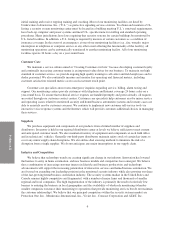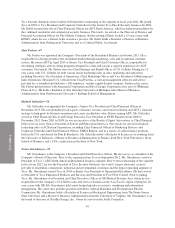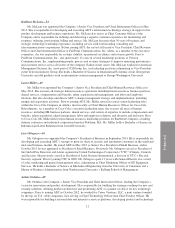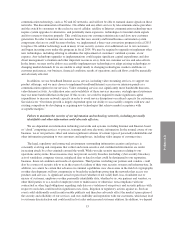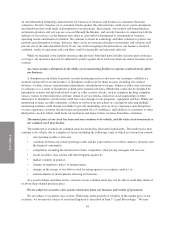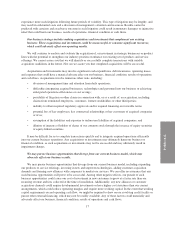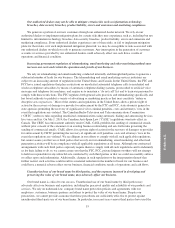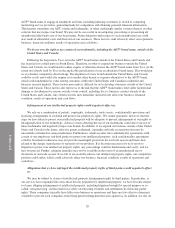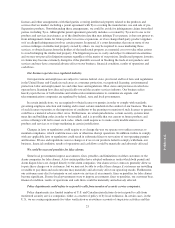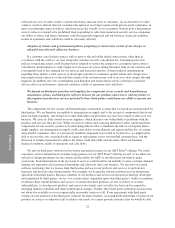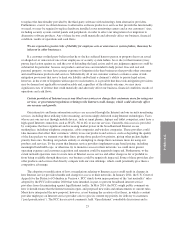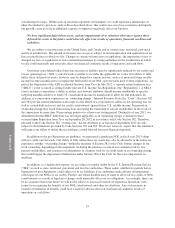ADT 2014 Annual Report Download - page 82
Download and view the complete annual report
Please find page 82 of the 2014 ADT annual report below. You can navigate through the pages in the report by either clicking on the pages listed below, or by using the keyword search tool below to find specific information within the annual report.
FORM 10-K
on our information technology infrastructure for business-to-business and business-to-consumer electronic
commerce. Security breaches of, or sustained attacks against, this infrastructure could create system disruptions
and shutdowns that could result in disruptions to our operations. Increasingly, our security and home/business
automation products and services are accessed through the Internet, and security breaches in connection with the
delivery of our services via the Internet may affect us and could be detrimental to our reputation, business,
operating results and financial condition. We continue to invest in technology and other solutions to protect our
network and information systems, however, there can be no assurance that these investments and solutions will
prevent any of the risks described above. If any one of the foregoing risks materializes, our business, financial
condition, results of operations and cash flows could be materially and adversely affected.
While we maintain cyber liability insurance that provides both third party liability and first party insurance
coverages, our insurance may not be sufficient to protect against all of our losses from any future breaches of our
systems.
An event causing a disruption in the ability of our monitoring facilities to operate could adversely affect
our business.
A disruption in our ability to provide security monitoring services and serve our customers could have a
material adverse effect on our business. A disruption could occur for many reasons, including fire, natural
disasters, weather, disease, transportation interruption, extended power outages, human or other error, terrorism
or sabotage or as a result of disruptions to third-party transmission lines. Monitoring could also be disrupted by
information systems and network-related events or cyber security attacks, such as computer hacking, computer
viruses, worms or other malicious software, denial of service attacks, malicious social engineering or other
destructive or disruptive activities that could also cause damage to our properties, equipment and data. While our
monitoring systems are fully redundant, a failure of our back-up procedures or a disruption affecting multiple
monitoring facilities could disrupt our ability to provide monitoring services. If we experience such disruptions,
we may experience customer dissatisfaction and potential loss of confidence, and liabilities to customers or other
third parties, each of which could harm our reputation and impact future revenues from these customers.
The market price of our stock has been and may continue to be volatile, and the value of an investment in
our common stock may decline.
The market price at which our common stock has traded has fluctuated significantly. The market price may
continue to be volatile due to a number of factors including the following, some of which are beyond our control:
• our operating results or forecasts;
• variations between our actual operating results and the expectations of securities analysts, investors and
the financial community;
• competition, including the introduction of new competitors, their pricing strategies and services;
• recent securities class actions and other litigation against us;
• market volatility in general;
• changes in regulatory policy or interpretation;
• changes in the ratings of our debt or stock by rating agencies or securities analysts; or
• announcements of developments affecting our business.
As a result of these and other factors, investors in our common stock may not be able to resell their shares at
or above their original purchase price.
We are subject to securities class actions which may harm our business and results of operations.
We are subject to securities class actions. Following certain periods of volatility in the market price of our
securities, we became the subject of securities litigation as described in Item 3 “Legal Proceedings.” We may
16


